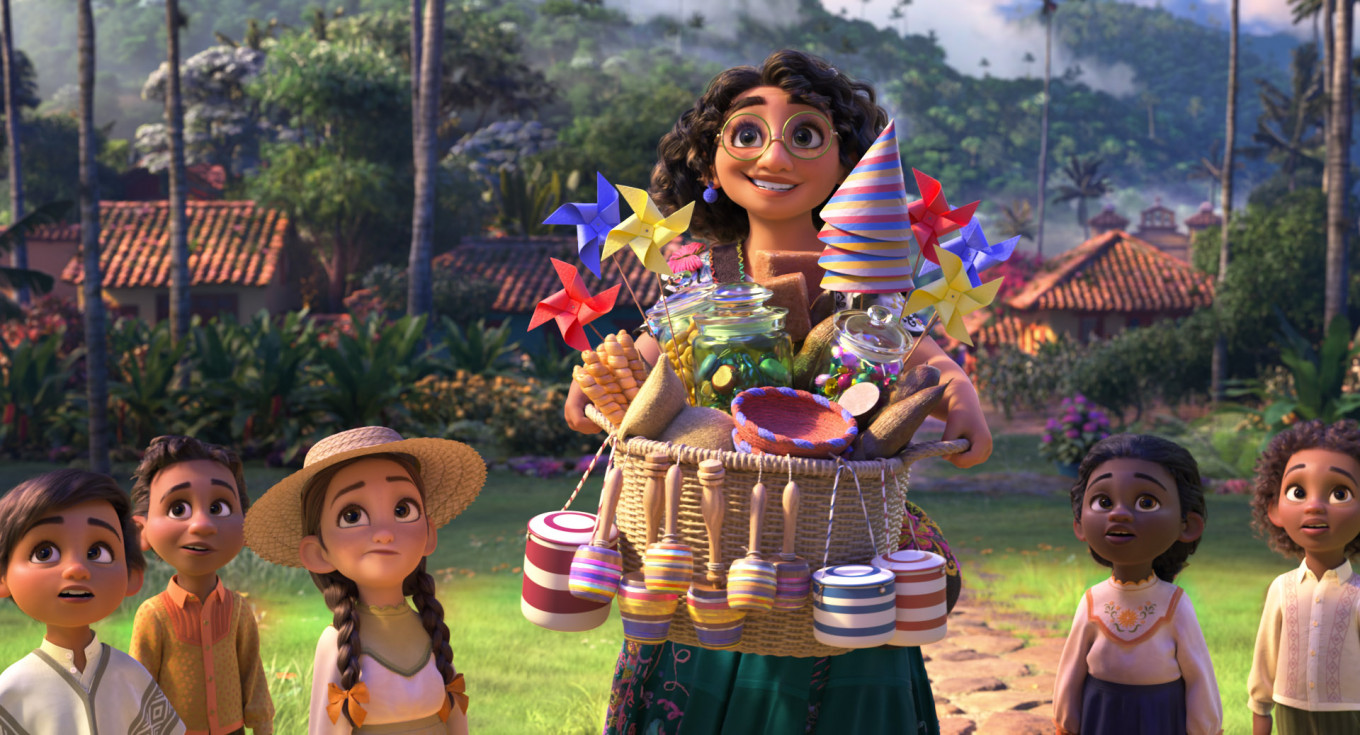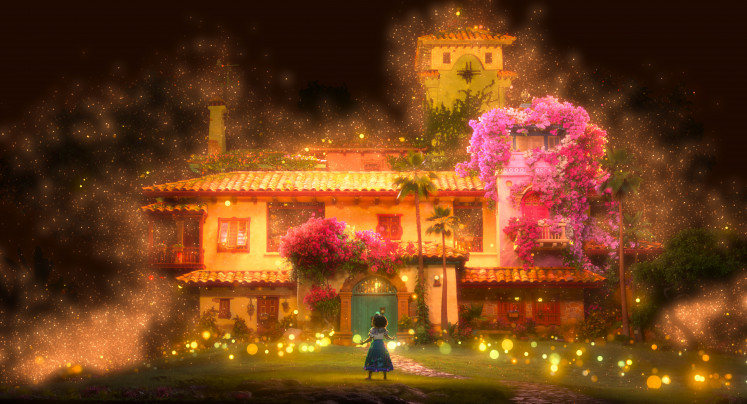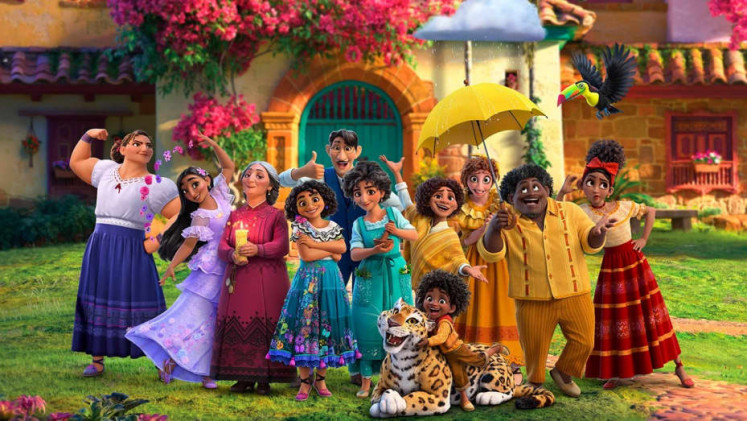Popular Reads
Top Results
Can't find what you're looking for?
View all search resultsPopular Reads
Top Results
Can't find what you're looking for?
View all search resultsThe magical reality of Disney's 'Encanto'
The new Disney princess is delightfully relatable.
Change text size
Gift Premium Articles
to Anyone
The new Disney princess is delightfully relatable
(This review contains mild spoilers)
Enter the magical community of Encanto, where the villagers live a happy, prosperous life under the protection of the magical family Madrigal. Each of the Madrigal family members have their own miraculous ability that is imperative for the sustenance of the village: One has healing powers, another can control the weather and one is a gentle giant with super strength.
The center of the story, however, is the muggle of the family. Fifteen-year-old Mirabel Madrigal, despite her miraculous name, is not bestowed with magical gifts and has to live watching her sisters and cousins grow to be enchanters. Unsurprisingly, her caring, selfless character plays a key role in the story.
Disney’s newest feature animation Encanto takes inspiration from the beauty of Columbia’s nature and culture. The colorful village of Encanto is surrounded by lush hills and winding rivers, an homage to the South American landscape. The elaborate costume, lively music and dancing, as well as the splendorous spread of flowers, cacti and trees are made to look faithful to Columbia’s rich culture and biodiversity.
The computer-animated musical fantasy comedy is the 60th film produced by Walt Disney Animation Studios. Distributed by Walt Disney Studios Motion Pictures, Encanto premiered at the El Capitan Theatre in Los Angeles on Nov. 3. In Indonesia, it premiered in Plaza Senayan, South Jakarta on Tuesday.
Directed by Byron Howard and Jared Bush, with original songs written by Lin-Manuel Miranda of Hamilton, the voice actors are mostly Latinx actors such as Stephanie Beatriz, John Leguizamo, María Cecilia Botero, Diane Guerrero, Angie Cepeda and Wilmer Valderrama.
The magical reality
Everything made by Disney seems to have a trace of fairy dust in it, but with Encanto, the studio goes full throttle with Columbian magical realism.
Magical realism as a literary genre is a huge movement in Latin America, reaching its peak in the 1940s and 1950s with prominent writers from Argentina, Chile, Brazil and Columbia. However, one of the biggest literary figures whose works are often considered synonymous with the genre is Nobel prize winner and Colombian writer Gabriel Garcia Marquez. His 1967 magnum opus One Hundred Years of Solitude is often dubbed as the genre’s most canonical incarnation and considered as the cornerstone of Latin America’s magical realism tradition.
Disney’s Encanto gives almost too many nods to Marquez’ One Hundred Years of Solitude. Marquez’ novel follows the Buendía family from the time they built the first houses in the new town of Macondo through the long life of the family’s matriarch, Úrsula. Meanwhile, Encanto follows the newlywed Alma and Pedro Madrigal pioneering the new town of Encanto within a solitary part of the Columbian tropical jungle until Alma reaches an old age and becomes the clan’s matriarch. Yellow butterflies, a sign of passionate romance in Marquez’ novel, also appear in the film to signify the budding love of young Alma and Pedro Madrigal.
In the world of magical realism, the characters tend to accept extraordinary magical occurrences as mundane parts of daily life. In Marquez’s Solitude, the people in Macondo simply shrug their shoulders at occurrences such as wandering spirits, an insomnia epidemic and an unwashable Ash Wednesday cross. In contrast, they celebrate scientific discoveries such as a block of ice and railroad tracks as extraordinary sights.
In Encanto, the Madrigal family lives in a magic house they call Casita, a smart home the Disney way. Not only does the house’s clapped tiles and flapping window shutters help keep things clean and in order, Casita is also the center of the Madrigals’ magical power. When each member of the family has come of age, Casita will add a new special door leading to a new elaborate chamber especially designed for that person’s magic.
The magic running through the Madrigal family bloodline is practical for the villagers such that they become dependent on the Madrigals, and it is just normal that they keep it that way. Therefore, when there is one Madrigal that cannot perform magic, it is counted as absurdity.
The relatable, magical sisters
The decision to choose Mirabel, the non-magical one, to be the main protagonist of the story shows that Disney continues with the trend of giving more spotlight to empowered young girls. Determined female protagonists such as Juddy Hopps in Zootopia (2016) and Moana in Moana (2016), even the mild deconstruction of Rapunzel in Tangled (2010) detaching her from a trope of princess-trapped-in-a-tower to a more curious, adventurous girl, put and end to the damsel-in-distress stereotype of Disney’s classic princesses: beautiful princesses caught in misery waiting to be rescued by a gallant Prince Charming.
The Magical Family Madrigal: Each of the Madrigal family members have their own miraculous ability that is imperative for the sustenance of the village. (Courtesy of Disney) (Disney/Courtesy of Disney)Mirabel is not of “exceptional beauty”, like Snow White, Ariel or Aurora. Mirabel doesn’t dream of a marriage and doesn’t seem to care about the idea of a romantic relationship. Instead, Mirabel is a clumsy girl-next-door whose biggest dream is to make her family proud -- a character to whom many can relate.
Mirabel’s sisters are also designed to be more down to earth than any other Disney characters. Isabel, who can conjure beautiful flowers from thin air, is considered the town’s great beauty but behind closed doors she wishes that she could express herself more with thorny, wild bushes and cacti instead of the monotony of pink and purple shades of roses.
Luisa, the family’s muscle, is always at the ready whenever villagers need her to do heavy-duty chores. However, it turns out that she is burnt-out by her own people-pleasing attitude and worried whether her existence is only to serve others.
With small children as its primary target audience, the sisters’ mental and physical complexity introduce the diversity of human bodies and characters to the young spectators. It is indeed a breath of fresh air when the screen is no longer dominated by whitewashed, twiggy females whose life is only complete when encountering a male romantic interest. Encanto charms the audience with the notion that what is relatable and familiar also can be curiously magical.












